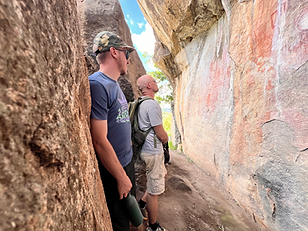Malawi's Heritage
Malawi’s culture isn’t tucked away in museums—it’s woven into everyday life. You’ll find it in the ancient rock art of Chongoni, a UNESCO World Heritage Site where paintings dating back thousands of years still mark sacred hillsides.
You’ll feel it at Mua Mission, where traditional dances, mask making, and wood carving keep old customs alive in vibrant, creative ways.
From spiritual shrines to village celebrations, Malawi’s heritage is something you don’t just learn about—you experience it. It’s rich, welcoming, and still very much part of the present.

Chongoni Rock Art

Hidden in the stone hills and forests of Dedza, the Chongoni Rock Art Area is one of those places that just feels special. The hikes through the forest are beautiful on their own—twisting paths, massive boulders, and sweeping views—but then you reach the rock shelters, and it all gets quiet.
Some of the red ochre paintings are thought to be up to 10,000 years old, left by ancient pygmy hunter-gatherers. Later, the Chewa people added their own white-painted symbols—marking ceremonies, spirits, and community life that still matter today.
You don’t need to be an expert to appreciate it. The art, the stillness, the sense of time—it all just sinks in.
It’s not flashy, but it stays with you. There’s something powerful about standing in the same spots people have been painting in for thousands of years.








Mulanje Mountain

There’s something about Mulanje that just feels otherworldly. Rising out of the tea fields like a giant, it’s no surprise the locals call it the Island in the Sky. It’s not just a mountain—it’s wrapped in stories and mystery, with legends of spirits, hidden creatures, and unexplained disappearances that still get told today.
The hike to the top takes about three days, staying in simple mountain huts along the way. It’s tough in places, but the views, the silence, the waterfalls you stumble upon—it’s worth every step. You’ll pass through all kinds of landscapes, from thick rainforest to open grasslands to rocky alpine outcrops, with the air getting cooler and clearer the higher you go.
At times, it doesn’t even feel like Malawi anymore—just vast, quiet space, broken by the sound of water or wind through the trees. Whether you go for the challenge, the views, or just to be somewhere completely different, Mulanje has a way of sticking with you.

Mua Mission


Tucked into the hills above Lake Malawi in Mua, Dedza District, the Kungoni Centre of Culture and Art is one of those places that quietly blows you away. What started as a small woodcarvers’ cooperative has grown into a rich cultural institution—home to the Chamare Museum, the Kafukufuku research library, a women’s cooperative called Ku Mbewu, and even its own lodge, Namalikhate.
The Chamare Museum is at the heart of it all, both in meaning and design. Shaped to resemble three tents under a baobab tree—a nod to the first missionaries who arrived at Mua in 1902—it explores the traditions of the Chewa, Yao, and Ngoni peoples who all call this area home. The exhibitions go deep into rituals, beliefs, and daily life, with striking masks, carvings, and storytelling that bring it all to life.
Kungoni’s influence stretches far beyond Mua. Its artists have decorated churches across Malawi and as far as Kenya, Germany, and even the Vatican Museums. But the soul of the place is local—rooted in the people, their stories, and their craftsmanship.
Whether you're watching a Gule Wamkulu dance, walking among the museum’s vibrant displays, or just talking to one of the carvers, Kungoni offers a powerful and personal glimpse into Malawi’s cultural heartbeat.















































































Zomba Plateau

Zomba is one of the few places in Malawi where you can really see the country’s history still standing. As the former colonial capital, it’s full of old buildings, red brick structures, and wide tree-lined streets that give it a feel you won’t find anywhere else. It’s probably the place with the most visible historical architecture in the country, and walking through town, you get a real sense of how things used to be.
Just above the city, the Zomba Plateau rises into cool, green forest. It’s a peaceful escape with amazing views, quiet trails, waterfalls, and fresh mountain air. You can spend your time hiking to Chingwe’s Hole, stopping at Emperor’s View, or just taking it all in from the edge of the cliffs. There are also options for horse riding and biking, and plenty of places to just sit and enjoy the scenery.
Zomba has a calm, lived-in charm. It’s a place that invites you to slow down, wander, and take in a side of Malawi that’s both beautiful and full of stories.

























